Racing version M-205. Year 1962. 247cc (54×54). 150 km/h
source: Tony Laan

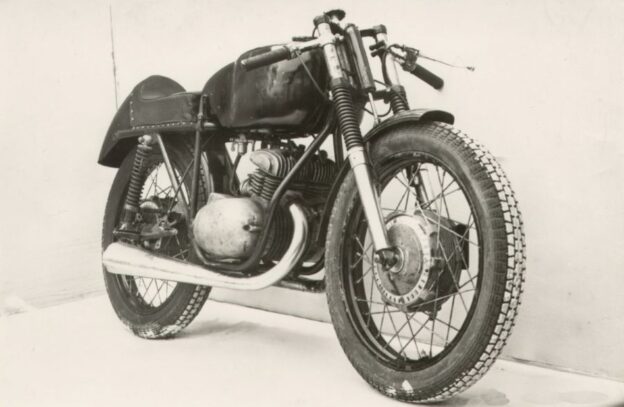
Racing version M-205. Year 1962. 247cc (54×54). 150 km/h
source: Tony Laan
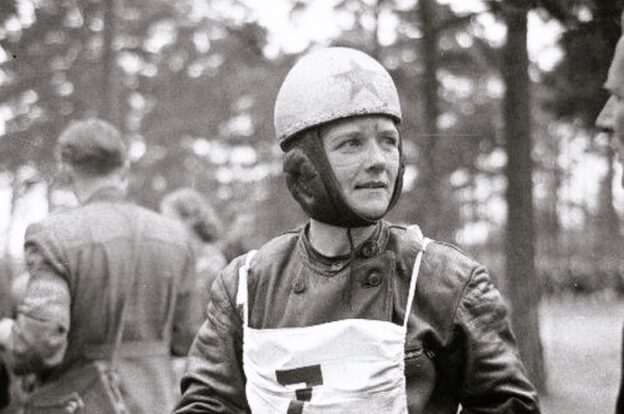
Irena Yanisovna Ozolina pictured at Pirita in 1956.
Irena Yanisovna Ozolina was born 31/08/1917 in Petrograd. She passed away 07/06/1983. She lived, worked and is buried in Moscow.
4-times Master of Sports of the USSR.
18-time champion and record holder of the USSR in motorsport including a quadruple in classes 350, 250 and 125 cm3.

photo: Valdis Kleinbergs (1939-1996) – President of the Latvian Motorsport Federation, with racing motorcycle Riga-15C
Valdis Kleinbergs was born in Latvia on 29 October 1939.
Many people have changed the international motorsport federation and motorsport community, and a large number have heard the name of Valdis Kleinberg but have never known or met him, but his name is still mentioned in the motorsport community, and this is the case even today when we should remind ourselves of Valdis.
Valdis was the first president of the Latvian Motorsport Federation after the restoration of Latvian independence after the Latvian peoples had been doomed to oblivions some time ago in their peoples age, first by the Germans and then the epoch of the USSR.
Valdis Kleinbergs, would have turned 75 in 2014, but unfortunately, he is no longer among us.
It was his dream that the Latvian motocross team could participate in the international Motocross des Nations. Latvia had not yet been reinstated in the ranks of the FIM, but he was already dreaming and hoping for it. A year later, Latvia successfully competed in Motocross des Nations, in 1992 in Australia.
Latvia had not yet been reinstated in the FIM, but motocross “Gaujas Kauss” was already on the FIM competition calendar. Being one of the initiators of the renewal of the Latvian Olympic Committee, Valdis Kleinbergs was most active in his “field” – motorsport.
Valdis experienced the debut of Latvian motorcyclists in the Motocross of Nations (he himself was present), experienced that Kristers Serģis and Artis Rasmanis scored the first points in the world championship, experienced the first round of the world championship in the history of motorsport in Latvia, although it was the 1/4 final of the speedway junior championship.
Unfortunately, Valdis didn’t manage to experience much of what he dreamed of… The first world championship for motocross crews in 1996 in Kegums, the first Sergis/Rasmanis world championship title, “Grand Prix” stages at the speedway, GP stages in MX1 and MX2 classes in Kegums and Nations des Motocross in Kegums, but Valdis Kleinbergs took a very active part in all these and many other events – someone should have been the first, someone should have started moving everything and he was the one who started doing it.
Remember the name of this great man, Valdis Kleinbergs. Rest in Peace.
He is survived by his son Raimonds Kleinbergs.
Memories by JD: I have very fond memories of meeting Valdis Kleinsberg along with his travelling companion Mr Juris Ramba. They had attended the FIM World Congress in Christchurch, New Zealand, where Valdis was Jury President. This was in early 1991, just months before Latvian independence was restored after the decades-long Soviet occupation on 21 August 1991. I have photos of their arrival at Sydney International Airport. We had a luxurious dinner at a swank restaurant. As we were leaving and thanking the staff a large cockroach ran across the foyer and Juris squashed it with his foot.
Then, as if by chance, my local racetrack, Amaroo Park (now a housing estate) hosted a large Historic motorcycle roadracing event. I knew some of the track officials, and we were quickly whisked thru the main entrance to the circuit and straight into the pits, also to the top of the control tower which had the best views. Valdis and Juris were in their element. That was an excellent day! I remember giving Valdis a beer, Hunter Old, to which he exclaimed, “Nectar!”
I have many photos of Valdis, but am limited to posting just one photo to this blog. You will see his name again!
the sources: Juris Ramba, Moto Vesture, Anatoly Kreipan, Сергей Пашацкий, USSR Sportsbikes, JD

For the record.
Czech motocrosser Miloslav Souchek turned 92 today.
The ESO Factory Racer.
He won twice the FIM Six-Day FIM in the team (1955 and 56).
Winner of the European Motocross Championship 1960.
Four times champion of Czechoslovakia.
source: Andrey Spitsun USSR Sportsbikes
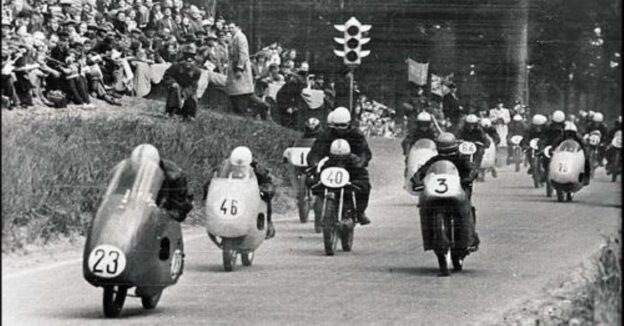
Estonian roadracing championships 1958
Gotta love those dustbin fairings!
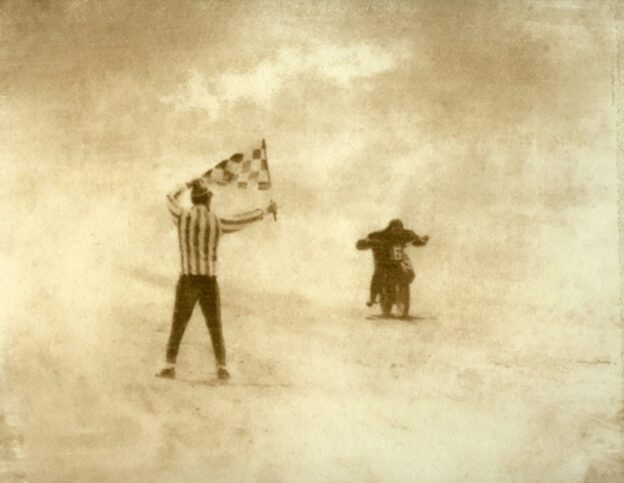
Racing flags are traditionally used in auto and motorcycle racing and similar motorsports to indicate track condition and to communicate important messages to racers. Typically, the starter, (sometimes referred to as the grand marshal) of a race, waves the flags atop a flag stand located at the start/finish line. But the most well-known is the chequered flag.
The chequered flag (or checkered flag, USA) is displayed at the start/finish line to indicate that a race is officially finished. At some race circuits, the first flag point will display a repeat chequered flag (usually on the opposite side of the circuit). The flag is associated with the winner of a race, as they are the first to “take” the win, (in other words, to pass) the chequered flag.
Upon seeing the chequered flag and crossing the finish line, participants are required to slow to a safe speed, and return to their pit garage, parc fermé (French: “closed park”), or paddock, depending on the applicable regulations of the series. Some pits are just that, pits.
Status flags are used to inform all racers of the general status of the course during a race. In addition, green, yellow, red. black and other flags may in modern racing, the waving by marshals and flags, be augmented or replaced by high-intensity lights at various points around the circuit.
There is no standard design for the chequered flag. Although it nearly always consists of alternating black and white squares or rectangles arranged in a chequerboard pattern, the number, size, and length-width proportions of the rectangles vary from one flag to another. Also, the chequered flag typically has a black rectangle at the corner of the flag closest to the top of the flagpole. There have been instances of the black and white squares being painted onto a wooden board and simply held up for participants to observe at the finish line.
It is said the chequered flag originated in 1906 at the Glidden Tours, a road rally held by the AAA in the USA. Sidney Walden divided the courses into sections; the time check at the end of each section was performed by race officials called “checkers”. These checkers used chequered flags to identify themselves.
The earliest known photographic record of a chequered flag being used to end a race was from the 1906 Vanderbilt Cup race held in Long Island, New York.
There is a persistent urban legend claiming that the flag originated in horse racing, but there is no basis for this myth. Another myth claims that the chequered flag’s earliest known use was for 19th century bicycle races in France, but this claim also has no evidence. Another suggestion is that excited ladies waved a chequered tablecloth to indicate to the spectators and racers that the racing was over and it was time to come and eat. But who can tell the now distant past?
The waving of twin chequered flags at the end of a race is also sometimes used. This tradition was accredited to USAC Duane Sweeney at the Indianapolis 500 in 1980 by waving twin chequered flags vigorously at the end of the race. Previously, only a single flag had been used.
In some instances, the winner is handed the chequered flag to celebrate the win with a victory lap.
Today the chequered flag is not only used for racing but has become a representation of the automotive industry itself.
Racing’s Holy Grail is the Chequered flag.
Retrieved from the lost archives by JD. Artist/photographer unknown, it is a great picture!
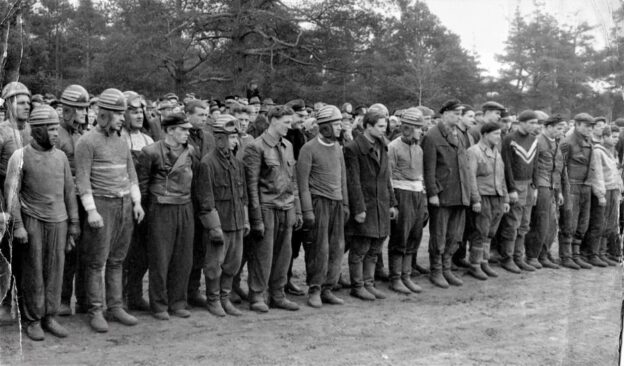
Raceday parade of riders.
Anyone know which location? What year?
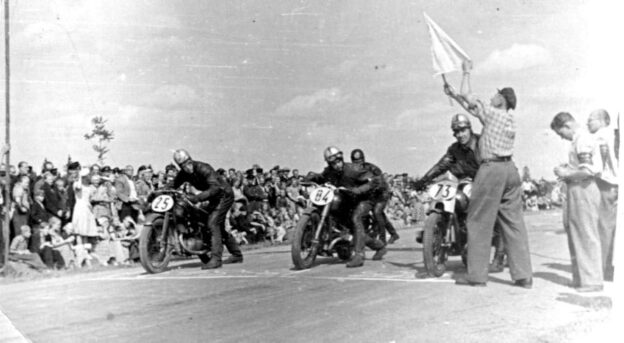
Starting grid Izh vs opposites! 1954
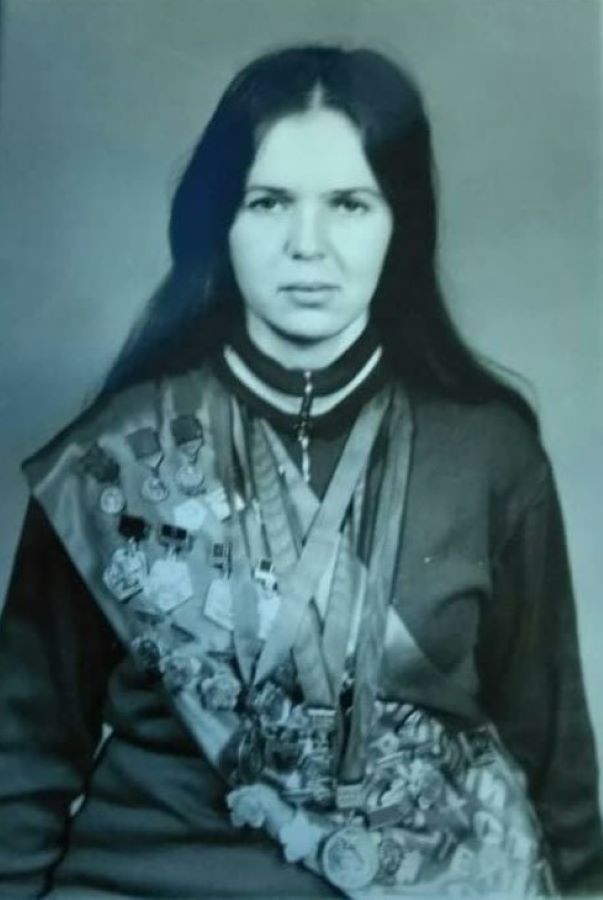
Unknown hero. Can someone tell her name?
Reposting this after loss of posts January/August 2022.
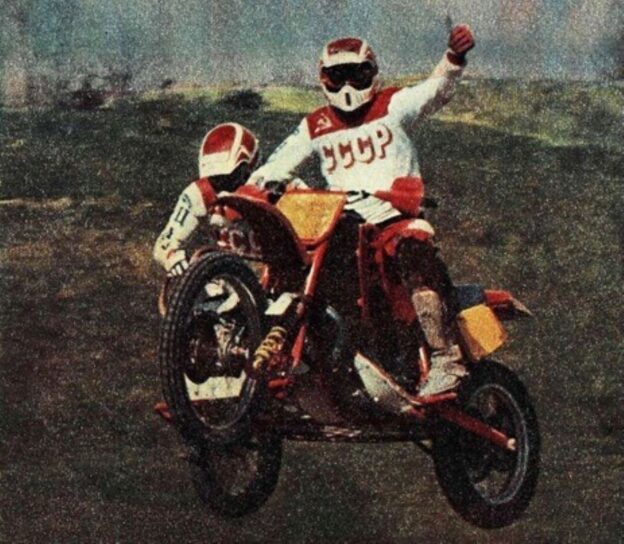
VNIImotoprom 2-stroke motocross
За рулем 5/1990 (At the wheel) cover photo